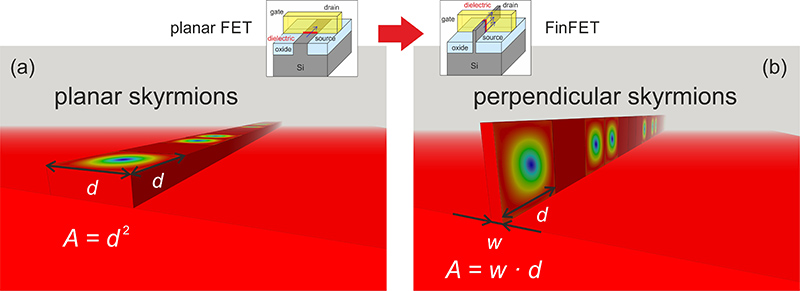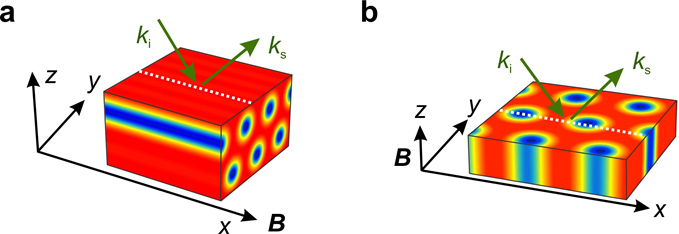The search for improved information carriers remains a major task in data storage technology research. The ideal candidate should be stable against external disturbance such as temperature or field fluctuations, it should allow for low-power manipulation and easy readout, combined with a small footprint enabling high packing densities. In principle, magnetic skyrmions fit the requirements well and are therefore undergoing a data storage sanity check.
Scientists from SEXTANTS beamline, ShanghaiTech University, Diamond Light Source (Magnetic Spectroscopy Group), and the University of Oxford discovered of a novel skyrmion surface state that exists in applied in-plane fields – much different from the usual out-of-plane geometry. Their results are reported in Nano Letters.
The key advantage of the skyrmions arises from their topological properties: its particular magnetic moment configuration, i.e., the self-protecting vortex structure, is robust against certain distortions. Their topology also induces novel magnetoelectrical effects, allowing for efficient manipulation and detection.

Figure 1: Illustration of (a) the conventional in-plane skyrmion state and (b) the novel perpendicular skyrmion state in the non-centrosymmetric skyrmion system Cu2OSeO3. Whereas a conventional planar skyrmion takes up an area of A=d2 (d is the skyrmion diameter), a perpendicular skyrmion has a much reduced lateral footprint of A = w d (with w the width of the ridge) which is advantages for skyrmion memory applications..
In principle, the most straightforward way of making use of skyrmions for memory devices is to assign a logic 0 or 1 to the absence or presence of a skyrmion in a magnetic racetrack memory scheme. Many of the components needed for an experimental realization of this technology have recently been reported in the literature. Nevertheless, two key issues remain challenging. First, skyrmions have to be controlled to keep their distance during their movement along the racetrack, i.e., the encoded information has to be preserved. Second, the storage density in this conventional racetrack design is governed by the skyrmion diameter, as shown in Fig. 1a. In analogy to the introduction of perpendicular memory, an improved version of a racetrack can be achieved by erecting the bits as a `perpendicular skyrmion array’, as shown in Fig. 1b. In this case, the storage density is merely governed by the skyrmion depth itself, as the thickness of a skyrmion is theoretically vanishing due to its two-dimensional nature!

Figure 2: Geometries for a REXS experiment on a magnetic skyrmion lattice. (a) In-plane geometry. (b) Out-of-plane geometry showing the typical skyrmion tubes.
When carrying out their REXS study in the in-plane geometry (Fig. 2a) and not in the commonly studied out-of-plane geometry (Fig. 2b) on the well-known skyrmion crystal Cu2OSeO3, the research team was surprised by the emergence of an exotic surface skyrmion lattice state. They found that the skyrmion array survives at very low temperatures, much different from the known, tiny skyrmion pocket in out-of-plane fields (Fig. 3a). In fact, at low temperatures, skyrmions only ‘float’ at the very surface of the bulk sample, above a sea of conical spirals, similar to a “terrine de chocolat aux cigarettes russes” (Fig. 3b). The thickness of this surface state is estimated to be only 120 nanometers by making uses of the energy dependence of the probing depth (Fig. 3c). The REXS penetration length λ (1/e drop in intensity) is shown as a function of photon energy in the figure. The blue dots represent the energies used for surface-sensitive (931.2 eV) and bulk-sensitive (926.2 eV) conditions. Further, by applying an oblique magnetic field, the team demonstrated that the surface skyrmion array is strongly ‘pinned’ to the surface, resisting the field tilting.

Figure 3: (a) Magnetic phase diagram determined by REXS. Apart from the well-known skyrmion bulk state, which exists in a small pocket (red) of the phase diagram, the skyrmion surface state was found in a much extended parameter space. (b) This surface state resembles the famous French dessert, with surface-bound skyrmion tubes. (c) The key to measuring the depth dependence of magnetic structures is the energy dependence of the magnetic probing depth. Whereas the probed depth is very shallow at resonance (~32 nm), the photons probe much deeper off-resonance (~120 nm).
The discovery of surface-pinned skyrmions has important implications for technological applications of magnetic skyrmions. First, as the surface provides an attractive potential for the skyrmions, the engineering of surfaces and interfaces allows for the precise tuning of skyrmion properties. Further, the robustness of surface skyrmions against both temperature and magnetic field variations makes them ideal contenders for magnetic bits. Finally, the ability to go ‘perpendicular’ will enable new design concepts for skyrmion memory.
Acknowledgements:
Semiconductor Research Corporation (SRC)
EPSRC (UK) (EP/N032128/1)
SOLEIL and Diamond for beamtime
